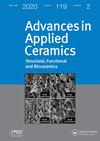Multi-scale decomposition enhancement algorithm for surface defect images of Si3N4 ceramic bearing balls based on stationary wavelet transform
IF 1.6
4区 材料科学
Q3 MATERIALS SCIENCE, CERAMICS
引用次数: 7
Abstract
ABSTRACT In order to improve the detection efficiency and image quality of Si3N4 ceramic bearing balls surface defects, digital image processing technology is used to analyse the information characteristics of Si3N4 ceramic bearing balls surface. A multi-scale decomposition enhancement algorithm for surface defect images of Si3N4 ceramic bearing balls based on the stationary wavelet transform is proposed. By building the surface defects detection system of Si3N4 ceramic bearing balls, the image enhancement program based on stationary wavelet transform with index low-pass filtering and nonlinear transform enhancement is designed. Finally, the effectiveness of the algorithm is verified by experiments. The experimental results show that the algorithm is applied to the surface defects image of Si3N4 ceramic bearing balls can effectively weaken the background noise and surface grinding texture, and enhance the contrast between defects and background clearly. In addition, the binary image is obtained by an adaptive threshold binary algorithm. After removing the tiny points by morphological opening operation, the defects are accurately and completely segmented, and then the Canny operator is used for edge detection to extract the edge contour of defects. When the decomposition level is set to 3, the average calculation time is 0.88 s, which are relatively short and have sufficient precision, and the algorithm can be extended to other kinds of ceramic ball surface damage detection.基于平稳小波变换的Si3N4陶瓷轴承球表面缺陷图像多尺度分解增强算法
摘要为了提高Si3N4陶瓷轴承球表面缺陷的检测效率和图像质量,采用数字图像处理技术对Si3N4陶瓷轴承球表面缺陷的信息特征进行分析。提出了一种基于平稳小波变换的Si3N4陶瓷轴承球表面缺陷图像多尺度分解增强算法。通过构建Si3N4陶瓷轴承球表面缺陷检测系统,设计了基于指数低通滤波和非线性变换增强的平稳小波变换图像增强方案。最后,通过实验验证了算法的有效性。实验结果表明,将该算法应用于Si3N4陶瓷轴承球表面缺陷图像,可以有效地减弱背景噪声和表面磨削纹理,明显增强缺陷与背景的对比度。此外,采用自适应阈值二值算法获得二值图像。通过形态学打开操作去除微小点后,对缺陷进行准确完整的分割,然后利用Canny算子进行边缘检测,提取缺陷的边缘轮廓。当分解等级设置为3时,平均计算时间为0.88 s,相对较短且具有足够的精度,该算法可推广到其他类型的陶瓷球表面损伤检测。
本文章由计算机程序翻译,如有差异,请以英文原文为准。
求助全文
约1分钟内获得全文
求助全文
来源期刊

Advances in Applied Ceramics
工程技术-材料科学:硅酸盐
CiteScore
4.40
自引率
4.50%
发文量
17
审稿时长
5.2 months
期刊介绍:
Advances in Applied Ceramics: Structural, Functional and Bioceramics provides international coverage of high-quality research on functional ceramics, engineering ceramics and bioceramics.
 求助内容:
求助内容: 应助结果提醒方式:
应助结果提醒方式:


